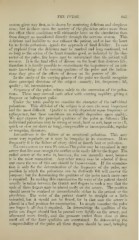Page 653 - My FlipBook
P. 653
THE PULSE. 663 ;
system gives way first, as is shown by muttering delirium and sleepless-
ness ; but in these cases the anxiety of the physician arises more from
the effect these conditions will ultimately have on the circulation than
from danger as manifested directly through the nervous system. This
delirium and inability to rest exhaust the patient, and at last the heart
by its feeble pulsations signals the approach of fatal debility. In case
of typhoid fever the delirium may be marked and long continued, yet
so long as the action of the heart remains good, as indicated by the cha-
racter of the pulse, fair hopes may be entertained that the patient will
recover. It is the final effect of disease on the heart that destroys life
therefore it is hardly possible to overestimate the importance of an inti-
mate knowledge of the varying qualities of the pulse and the indica-
tions they give of the effects of disease on the powers of life.
In the study of the varying phases of the pulse we should recognize
three principal divisions of the subject—namely, 1st, frequency ; 2d,
quality ; 3d, intermittence.
Frequency of the pulse relates solely to the succession of the pulsa-
tions. These may succeed each other with varying rapidity, giving a
frequent or infrequent pulse.
Under the term quality we consider the character of the individual
pulsations. This division of the subject is at once the most important
and the most difficult. Quality is rarely dependent upon frequency or
infrequency, but these conditions are usually dependent upon quality.
We may express the principal qualities of the pulse as follows : The
individual pulsations may be strong or weak, hard or soft, large or small,
quick or slow (or short or long), compressible or incompressible, regular
or irregular, dicrotous.
Intermittence is the failure of an occasional pulsation. This may
occur very regularly, or it may be irregular in its occurrence. ]More
frequently it is the failure of every third or fourth beat or pulsation.
ExAMiXATiox OF THE PuLSE.—The pulse may be examined in any
artery that lies near enough the surface to be easily felt by the finger. The
radial artery at the wrist is, however, the one generally used, because
it is the most convenient. Any other artery may be selected if from
any cause the use of this one should be inconvenient. If the examina-
tion is only for the determination of the frequency of the pulse, any
position in which the pulsations can be distinctly felt will answer the
purpose ; but for determining the qualities of the pulse much more care
is required. In making this examination the wrist of the patient should
usually be taken between the thumb and fingers in such a way that the
ends of three fingers may be placed easily on the artery. The position
should never be strained or uncomfortable either to the patient or the
physician. The wrist of the patient should be straight or a little
extended, but it should not be flexed, for in that case the artery is
placed in a bad position for examination. In simply counting the pulse
one finger is all that is required. In determining the qualities of the
pulse one finger should first be pressed very lightly on the artery, and
afterward more firmly, and the pressure varied from time to time
until all of the finer qualities are ascertained. In determining the
compressibility of the pulse all three fingers should be used, bringing


